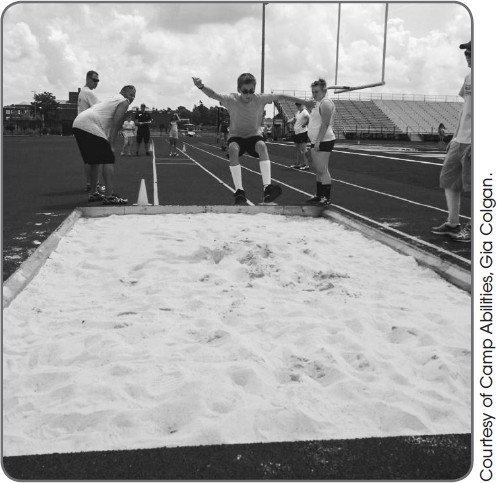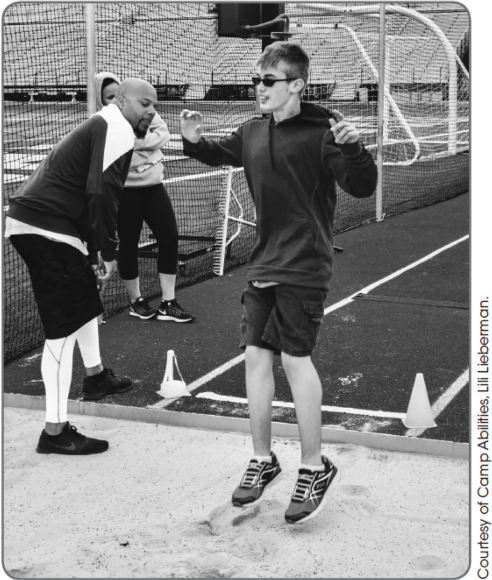Universally Designed Lesson Plans for Elementary PE
This is an excerpt from Universal Design for Learning in Physical Education With Web Resource by Lauren J Lieberman,Michelle Grenier,Ali Brian,Katrina Arndt.
By Emily N. Gilbert and Adam Pennell
Lesson 7: Track and Field
Track and Field
Grade Level: High School
National Standards
Standard 1. The physically literate individual demonstrates competency in a variety of motor skills and movement patterns.
Standard 2. The physically literate individual applies knowledge of concepts, principles, strategies and tactics related to movement and performance.
Standard 3. The physically literate individual demonstrates the knowledge and skills to achieve and maintain a health-enhancing level of physical activity and fitness.
Grade-Level Outcomes
S1.H1.L1. Demonstrates competency and/or refines activity-specific movement skills in 2 or more lifetime activities (outdoor pursuits, individual-performance activities, aquatics, net/wall games or target games).
S2.H2.L1. Uses movement concepts and principles (e.g., force, motion, rotation) to analyze and improve performance of self and/or others in a selected skill.
S3.H8.L1. Relates physiological responses to individual levels of fitness and nutritional balance.
Activity 1: Pace Yourself
Time: 15 minutes
Description: Students are allotted 12 minutes to run as far as they can. Before beginning, the teacher discusses the importance of self-pacing for distance running. In addition to discussing the importance of pacing, the teacher should provide a video example describing how to begin pacing their own running. Here is an example: https://www.runtothefinish.com/how-to-pace-yourself-while-running/. The purpose of this task is for the students to challenge themselves with a pace that is difficult but that they can maintain for 12 minutes. Students can choose to run, jog, or speed walk, and they may also pair up with a partner to help motivate each other. The teacher should emphasize not stopping until the time limit is up.
Cues:
- Breathing—in through your nose and out through your mouth
- Land midfoot and roll to forefoot (balls of your feet)
- Slight forward lean
- Land quietly (no bounce)
Organization: We recommend using a track, but the activity can be done in a gymnasium or other location where the teacher has an optimal view of the students.
Activity 2: Sprinting—10, 20, 30, 40, 50
Time: 15 minutes
Description: During this task, students focus on sprinting starts while steadily increasing the distance. The students start by sprinting 10 meters and jogging back, then 20 meters and jogging back, and so on. This continues until all the students reach 50 meters. Each new distance begins when everyone is back in their lane and ready to go so that no one is left behind. The students can select from a standing start, down start, or block start. To support the teacher's instruction, provide pictures for the students showing standing, down, and block starts. This will help the students compare the different types of starts. The teacher should emphasize starting form, staying in the marked lane, and smooth transition into sprinting form.
Cues:
- Verbal start signal: “Take your mark, get set, go”
- Visual start signal: Wave green flag
- Lead leg should be dominant leg
- Standing start—arms bent in opposition
- Down start and block start:
- Hands parallel with the start line
- Head down
- “Set”—hips go up
- “Go”—push off in forward motion
Organization: The students select their starting stance, then start in a group with each student in a lane (may have multiple heats). We recommended using the straightaway of a track, but the activity can be done in a gymnasium or other location where there is a straightaway (preferably a minimum of 60 meters).
Activity 3: Long Jump
Time: 15 minutes
Description: During this task, students are focusing on jumping form. The students in this task start with bounding, starting small and progressively getting bigger (students may jump over different-sized cones). Students then move toward jumping for distance. The purpose of this task is to work on at least three of the four phases of long jump: approach, takeoff, flight, and landing. The students can attempt a standing long jump or a running long jump. Figure 10.19 shows a student performing a running long jump, and figure 10.20 shows a student performing a standing long jump. The teacher should emphasize takeoff, flight phase, and landing. After completing all three activities students will complete a self-assessment rubric on pacing, long jump, and running starts (see figure 10.21). Then the students will create a goal for the upcoming class.
Cues:
- Standing long jump
- Legs shoulder-width apart
- Crouch and backswing (should be quick before takeoff)
- Push off with both legs and drive hands up
- Land softly
- Running long jump
- Fast approach (students choose pace)
- Take off from one foot (measure from takeoff point instead of board)
- Drive both hands up
- Land softly
Organization: The students select standing or running long jump. For running long jump, students utilize a sand jumping pit (if possible). For standing long jump, students jump from the floor or ground to a long crash mat.

Figure 10.19  A student performs a running long jump.

Figure 10.20  A student performs a standing long jump.
Universally Designed Components
Multiple Means of Engagement
- The teacher provides multiple options for equipment and activity variation for students to select in order to be most successful and challenged in track and field. For example, students can choose the size of cone to jump over and a skill variation (standing long jump, running long jump).
Multiple Means of Representation
- The content of the lesson should be presented in multiple ways so that all students can access the material. For this lesson to supplement the teacher's instruction and demonstrations, video (pacing for running) and task pictures (running starts) were provided for the students.
Multiple Means of Action and Expression
- Teachers should allow students alternatives to express or demonstrate their learning. For this lesson, a skill rubric (figure 10.21) was selected as the self-assessment for students. Through the use of this tool, the students assess themselves and set a goal for the upcoming class. This assessment tool also accounts for the variation in skills chosen by the students as well as the concepts such as pacing.

Figure 10.21 Self-assessment rubric on pacing, long jump, and running starts.
More Excerpts From Universal Design for Learning in Physical Education With Web ResourceSHOP

Get the latest insights with regular newsletters, plus periodic product information and special insider offers.
JOIN NOW


